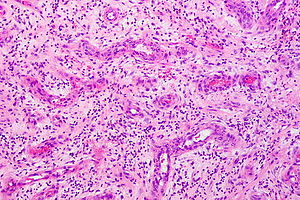Difference between revisions of "Granulation tissue"
Jump to navigation
Jump to search
(+infobox) |
|||
| Line 1: | Line 1: | ||
'''Granulation tissue''' forms when | {{ Infobox diagnosis | ||
| Name = {{PAGENAME}} | |||
| Image = Granulation tissue in an infected wound, HE 3.JPG | |||
| Width = | |||
| Caption = Granulation tissue. [[H&E stain]]. | |||
| Synonyms = | |||
| Micro = blood vessel rich - '''key element''', proliferation of fibroblasts - '''key element''', inflammation - especially lymphocytes ([[plasma cell]]s common) | |||
| Subtypes = | |||
| LMDDx = [[mucocele]], traumatized [[hemangioma]], [[pyogenic granuloma]] | |||
| Stains = | |||
| IHC = | |||
| EM = | |||
| Molecular = | |||
| IF = | |||
| Gross = granular appearance, erythematous | |||
| Grossing = | |||
| Site = [[skin]], [[gastrointestinal tract]], other | |||
| Assdx = | |||
| Syndromes = | |||
| Clinicalhx = +/-trauma | |||
| Signs = | |||
| Symptoms = | |||
| Prevalence = common | |||
| Bloodwork = | |||
| Rads = | |||
| Endoscopy = | |||
| Prognosis = benign | |||
| Other = | |||
| ClinDDx = | |||
| Tx = +/-debridement | |||
}} | |||
'''Granulation tissue''' forms when wounds heal. | |||
==Gross== | ==Gross== | ||
Revision as of 04:20, 2 January 2014
| Granulation tissue | |
|---|---|
| Diagnosis in short | |
 Granulation tissue. H&E stain. | |
|
| |
| LM | blood vessel rich - key element, proliferation of fibroblasts - key element, inflammation - especially lymphocytes (plasma cells common) |
| LM DDx | mucocele, traumatized hemangioma, pyogenic granuloma |
| Gross | granular appearance, erythematous |
| Site | skin, gastrointestinal tract, other |
|
| |
| Clinical history | +/-trauma |
| Prevalence | common |
| Prognosis | benign |
| Treatment | +/-debridement |
Granulation tissue forms when wounds heal.
Gross
- Looks granular, ergo the name granulation tissue.
Image
Microscopic
Features:
- Blood vessel rich - key element.[1]
- Small size ~ 25 micrometers in diameter.[citation needed]
- Proliferation of fibroblasts - key element.
- Inflammation - especially lymphocytes.
- Plasma cells common.
DDx:
- Mucocele.
- Pyogenic granuloma.
- Traumatized hemangioma.
Images
www:
Sign out
URINARY BLADDER, BIOPSY: - REGENERATIVE EPITHELIUM, INFLAMED SUBEPITHELIAL TISSUE AND GRANULATION TISSUE. - NO MUSCULARIS PROPRIA. - NEGATIVE FOR MALIGNANCY.
Micro
The sections show vascular tissue with plump fibroblasts, reactive endothelial cells and a mixed inflammatory infiltrate (granulation tissue). Focally, a dense cluster of neutrophils is seen at the luminal aspect.
A single layer of epithelium with pale, plump nuclei is present without apparent mitotic activity. Inflamed subepithelial tissue is present. No stratified urothelium is identified. No significant nuclear atypia is present.
See also
References
- ↑ Howdieshell TR, Callaway D, Webb WL, et al. (April 2001). "Antibody neutralization of vascular endothelial growth factor inhibits wound granulation tissue formation". J. Surg. Res. 96 (2): 173–82. doi:10.1006/jsre.2001.6089. PMID 11266270.
- ↑ URL: http://www.siumed.edu/~dking2/intro/inflskin.htm. Accessed on: 17 January 2011.



